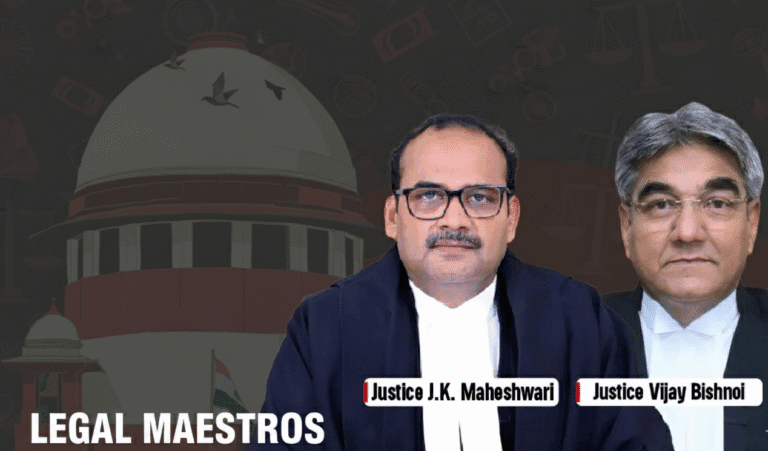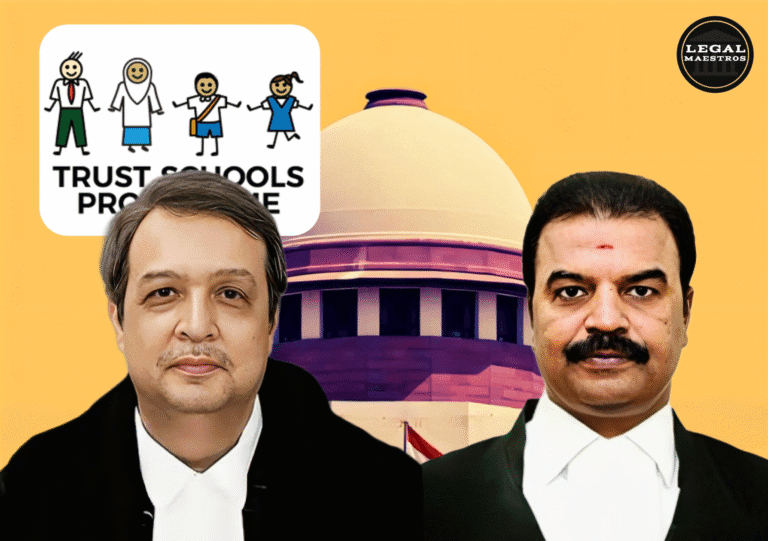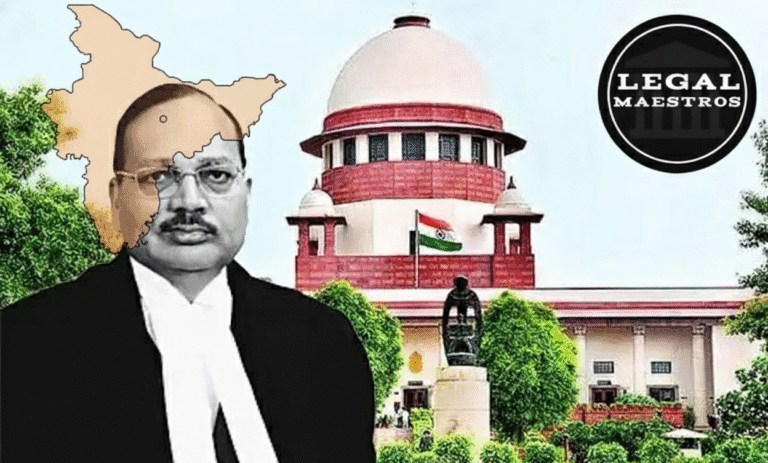
In G. Mohandas vs. State of Kerala & Ors. (2025 2 SCC 553) decided G. Mohandas was petitioned to quash the criminal proceedings against him on July 15, 2025 by the Supreme Court, which upheld the High Court of Kerala decision in rejecting the Petition, to set the precedent. In this case, which was dealt in the field of criminal appellate, there lies essential concerns of so-called conspiracy of crime, involvement in illegal constructive practice and abusing the offices. The judgment is that of the Supreme Court which was a result of an appeal to a High Court order dated January 16, 2024, and goes further into the interaction of other legal documents such as Prevention of Corruption Act, 1988, the Indian Penal Code, 1860, the Kerala Municipality Building Rules, 1999, etc.
case background The Contentious Building
The appellant in no.2 is G. Mohandas who is the owner of a building at Vanchiyoor Village in the district of Thiruvananthapuram. According to complainant, he had gotten into conspiracy with the officials of the Thiruvananthapuram Municipal Corporation and an architect to construct a new four-storeyed commercial building.The prosecution contended that Mohandas with a view towards promotion of a conspiracy with the Municipal Corporations officials had presented an application under the Rule 5(1) and Rule 144(1) of Kerala Municipality Building Rules, 1999 in furtherance of said conspiracy to seek permission of alteration and internal change in an existing building.Then the Municipal Corporation official gave permission under Rule 11(3) of the Rules strictly with the conditions to the renovation of the old building.
Conspiracy and getting Rules Violated
Most importantly, the prosecution claimed that such alterations and internal modifications indeed did not need any permit even according to the Rules. The Municipal Corporation officials had this knowledge yet gave the permit which was according to a bigger conspiracy. Misusing this so-called fake permit, Mohandas managed to demolish the old building and construct a four-storeyed commercial building in blatant non-compliance with the Rules.
For any queries or to publish an article or post or advertisement on our platform, do call at +91 6377460764 or email us at contact@legalmaestros.com.
The prosecution commenced when Dr. Biju Ramesh a businessman filed a complaint against Mohandas with the Secretary of the Municipal Corporation on the basis that Mohandas together with the officials of the municipal corporation had illegally built the commercial building.
Enquiry and registration of FIR
The Vigilance and Anti-Corruption Bureau led an unexpected check of the controversial building, on January 5, 2007, after the complaint. The report created an inspection report that caused Government to approve a vigilance enquiry on July 31, 2007. This investigation determined that Mohandas and Boston among other Municipal Corporation officials had colluded to aid the construction that was not built according to the law thus committing all the elements of offenses under Section 13(1)(d) read with Section 13(2) of the Prevention of corruption Act 1988 and Section 120B of the Indian Penal Code 1860.
As a result an FIR VC No. 3 of 2009 was laid against the Municipal Corporation officials and Mohandas (Accused No. 6) and the architect (Accused No. 7) on March 19, 2009. In the Section 173(2) of CrPC report made by the Investigating Officer, it further was reported that all the indicted parties knew that there was no permit requirement of the internal modifications and that the site of the said building was a restricted area in regard to the constructions of commercial buildings. Even after that Mohandas applied for what appeared as a mandatory permit and that was readily granted by the officials of Municipal Corporation though it was not a requirement. This was followed by submission of a chargesheet, i.e. Final Report No. 02 of 2020.
For any queries or to publish an article or post or advertisement on our platform, do call at +91 6377460764 or email us at contact@legalmaestros.com.
The arguments of appellant and the ruling of the High court
Feeling aggrieved by the proceedings, Mohandas made a Criminal Miscellaneous Petition (No. 330 of 2021) pursuant to Section 482 of the CrPC before the High Court in which he sought quashing of the proceedings. This was because his renovation request had been made in good faith. He also said that the building that collapsed earlier was because of heavy rainfall thus necessitating the construction of a new one. Mohandas also contended that because the Municipal Corporation has received his application towards regularisation of the alleged disputed building and asked him to give the fee of Rs. 18,58,653/- towards it, the section of the alleged crime should go away on payment of the compounding charges.
Moreover, Mohandas wanted to be at par with the architect (A. Dharamakeerthi), Accused No. 7, whose proceedings on a separate petition (Criminal Miscellaneous No. 2161 of 2020) were quashed on January 7, 2021 by the high court. The submissions by Mohandas did not augur well with the High Court who terminated his petition through an order dated January 16, 2024.
Cases In the Supreme Court
Senior counsel on behalf of Mohandas, Shri R. Basant, urged before the Supreme Court that those requirements needed by the chargesheeting following the concerned offenses had not been revealed. He cogently pointed out that the decision that had been reached by the Municipal Corporation to compound the building removed criminality. He had claimed that the building collapsed because of rain and he was simply reconstructing the old building, claiming that no rule had been broken, and this was particularly because the regularisation application had been approved.
For any queries or to publish an article or post or advertisement on our platform, do call at +91 6377460764 or email us at contact@legalmaestros.com.
On the contrary, these arguments were strongly refuted by Shri P.V. Dinesh, senior counsel appearing on behalf of the respondent-State. He refuted the fact by Mohandas that the building was collapsing because of rainfall as an imagination. He mentioned that on November 27, 2006 the Vigilance Department had served a stop memo and Mohandas had disobeyed the order by continuing the construction process and putting up a four-storey commercial building in a restricted area. Another aspect that Shri Dinesh pointed out was that such ex post facto regularisation by Mohandas of an illegal construction was not permissible since the area was a non-commercial area. He highlighted that the regularisation never happened since the act in crimes was already revealed since the vigilance enquiry had taken place. In addition he also told the Court that before the High Court dismissed his Section 482 CrPC petition the Special Judge had already ordered that he be charged on the basis of his findings.
Discussion in Supreme Court
The Supreme Court after a keen consideration agreed to the arguments of the respondent. It agreed that the Kerala Municipality Building Rules, 1999; do not specify that permission would be sought on alternation, renovations or internal changes of existing building. The Court dubbed that Mohandas had entered into conspiracy with Municipal Corporation officers of procuring such a permit which had been a precursor to a scheme of raising the development of a commercial building in a prohibited area which was/is a charade of raising the construction of a commercial building in a prohibited area. According to this, there was apparent conspiracy at the very beginning where the fraudulent action would get a “facade of legitimacy” and a certain form of “pre-emptive defence”.
The Court also held that Mohandas persisted with the construction on defiant note after he was sent a stop memo on November 27, 2006. A bold move to legitimize the illegal construction through regularising it is a fraud by him. The chronology, as given by the Court, clearly indicated the hand in glove movement of the appellant and the Municipal Corporation officials. The authorities made a deliberate blind eye of the fraudulent use of the renovation permit by the appellant in building rearing a commercial building and even accepted his fraudulent regularisation request in building an obviously illegal building in an illegal zone. The Court held that the elements of the offenses that were claimed were definite.
For any queries or to publish an article or post or advertisement on our platform, do call at +91 6377460764 or email us at contact@legalmaestros.com.
In summing up all this, the Supreme Court was so categorical in refuting the plea of parity between them and the architect. According to the Court, the architect was only performing professional duties when he drew architectural designs without engaging in active conspiracy or prior awareness of the conspiracy and unlawful construction. The appellant, therefore, was not at liberty to equate his treatment with that of the architect.
The Supreme court instructed the relevant authorities to act appropriately with the illegal construction. Finally, the appellate did not detect any defect in the order dated January 16, 2024, given by the High Court and used to reject the appeal by Mohandas since the latter lacked merit. This decision goes to support the uncompromising ardor of the judiciary on curbing corruption and unlawful activities, particularly where there is collusion of the authorities.




![Research Assistantship @ Sahibnoor Singh Sindhu, [Remote; Stipend of Rs. 7.5k; Dec 2025 & Jan 2026]: Apply by Nov 14, 2025!](https://legalmaestros.com/wp-content/uploads/2025/11/Gemini_Generated_Image_s0k4u6s0k4u6s0k4-768x707.png)
![Karanjawala & Co Hiring Freshers for Legal Counsel [Immediate Joining; Full Time Position in Delhi]: Apply Now!](https://legalmaestros.com/wp-content/uploads/2025/11/Gemini_Generated_Image_52f8mg52f8mg52f8-768x711.png)
![Part-Time Legal Associate / Legal Intern @ Juris at Work [Remote]: Apply Now!](https://legalmaestros.com/wp-content/uploads/2025/11/ChatGPT-Image-Nov-12-2025-08_08_41-PM-768x768.png)
![JOB POST: Legal Content Manager at Lawctopus [3-7 Years PQE; Salary Upto Rs. 70k; Remote]: Rolling Applications!](https://legalmaestros.com/wp-content/uploads/2025/11/ChatGPT-Image-Nov-12-2025-08_01_56-PM-768x768.png)